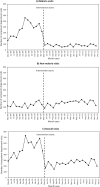Health Facility Utilisation Changes during the Introduction of Community Case Management of Malaria in South Western Uganda: An Interrupted Time Series Approach
- PMID: 26356099
- PMCID: PMC4565684
- DOI: 10.1371/journal.pone.0137448
Health Facility Utilisation Changes during the Introduction of Community Case Management of Malaria in South Western Uganda: An Interrupted Time Series Approach
Abstract
Background: Malaria endemic countries have scaled-up community health worker (CHW) interventions, to diagnose and treat malaria in communities with limited access to public health systems. The evaluations of these programmes have centred on CHW's compliance to guidelines, but the broader changes at public health centres including utilisation and diagnoses made, has received limited attention.
Methods: This analysis was conducted during a CHW-intervention for malaria in Rukungiri District, Western Uganda. Outpatient department (OPD) visit data were collected for children under-5 attending three health centres one year before the CHW-intervention started (pre-intervention period) and for 20 months during the intervention (intervention-period). An interrupted time series analysis with segmented regression models was used to compare the trends in malaria, non-malaria and overall OPD visits during the pre-intervention and intervention-period.
Results: The introduction of a CHW-intervention suggested the frequency of diagnoses of diarrhoeal diseases, pneumonia and helminths increased, whilst the frequency of malaria diagnoses declined at health centres. In May 2010 when the intervention began, overall health centre utilisation decreased by 63% compared to the pre-intervention period and the health centres saw 32 fewer overall visits per month compared to the pre-intervention period (p<0.001). Malaria visits also declined shortly after the intervention began and there were 27 fewer visits per month during the intervention-period compared with the pre-intervention period (p<0.05). The declines in overall and malaria visits were sustained for the entire intervention-period. In contrast, there were no observable changes in trends of non-malarial visits between the pre-intervention and intervention-period.
Conclusions: This analysis suggests introducing a CHW-intervention can reduce the number of child malaria visits and change the profile of cases presenting at health centres. The reduction in workload of health workers may allow them to spend more time with patients or undertake additional curative or preventative roles.
Conflict of interest statement
Figures




References
-
- Sirima SB, Konate A, Tiono AB, Convelbo N, Cousens S, Pagnoni F. Early treatment of childhood fevers with pre-packaged antimalarial drugs in the home reduces severe malaria morbidity in Burkina Faso. Trop Med Int Heal. 2003;8: 133–139. Available: http://onlinelibrary.wiley.com/doi/10.1046/j.1365-3156.2003.00997.x/abst... - DOI - PubMed
Publication types
MeSH terms
Grants and funding
LinkOut - more resources
Full Text Sources
Other Literature Sources
Medical

